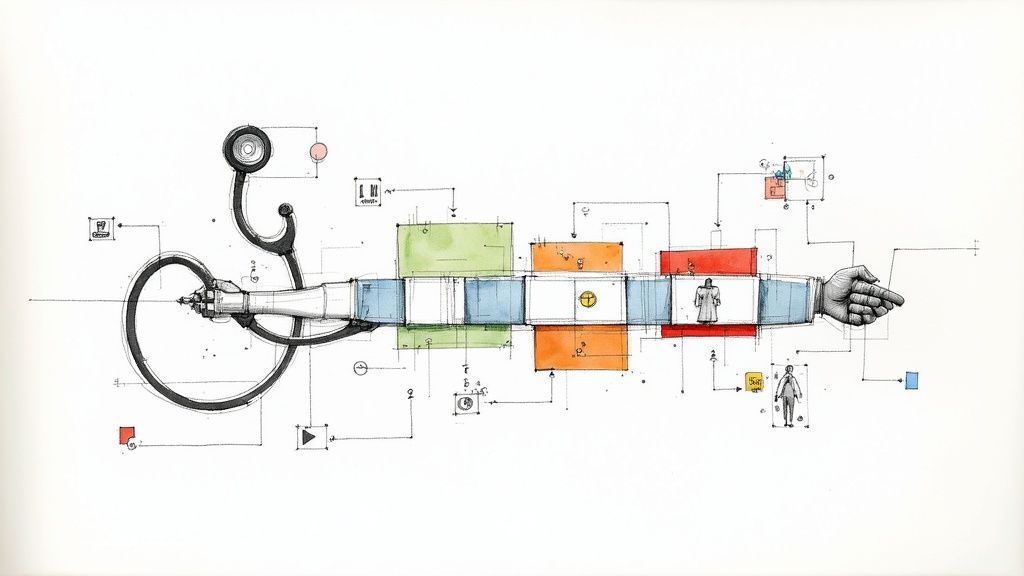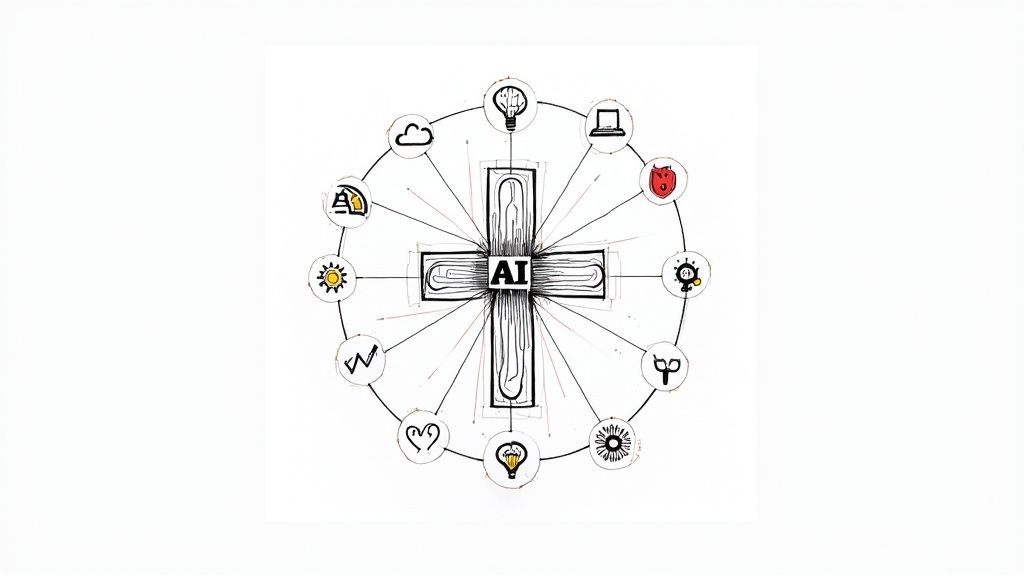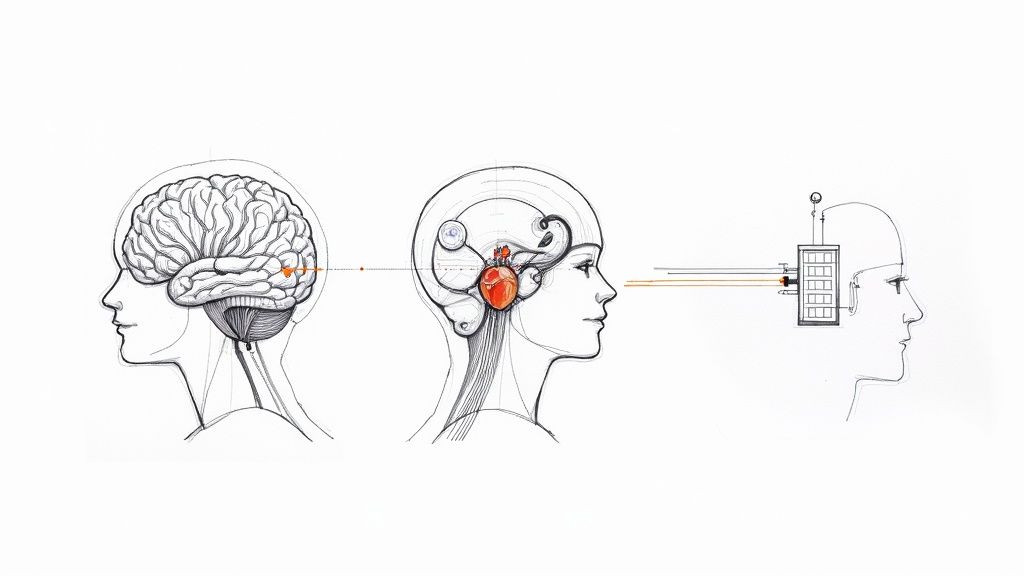Human AI Collaboration: Building Smarter Futures Together
Unlock the power of human AI collaboration. This guide explores frameworks, benefits, and real-world German examples to boost productivity and innovation.
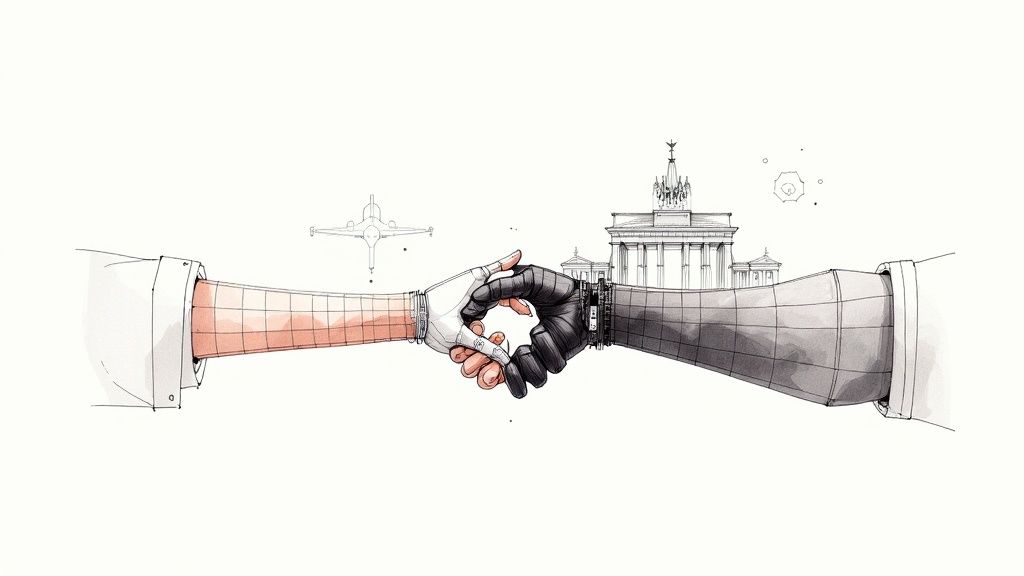
Human-AI collaboration is really a partnership. It’s about bringing together human ingenuity and artificial intelligence to tackle problems neither could solve on their own. The goal isn't to replace people; it’s about augmenting our skills with AI's incredible speed and data-processing capabilities. This synergy turns technology from a simple tool into a genuine partner in discovery and innovation.
Unpacking What Real AI Synergy Looks Like
Think of it like an expert pilot flying a modern aircraft. The pilot has years of experience, intuition, and the critical judgment needed to handle unforeseen turbulence or a sudden change in conditions. Meanwhile, the advanced autopilot system handles the routine aspects of the flight with flawless precision, continuously analysing thousands of data points to optimise the route and fuel consumption in ways a human never could.
Together, they make the journey safer and more efficient than either could manage alone. The pilot’s role isn't diminished—it's amplified. This is the heart of true AI co creation; technology becomes an intelligent force multiplier for human expertise.
Why This Partnership Is So Important Today
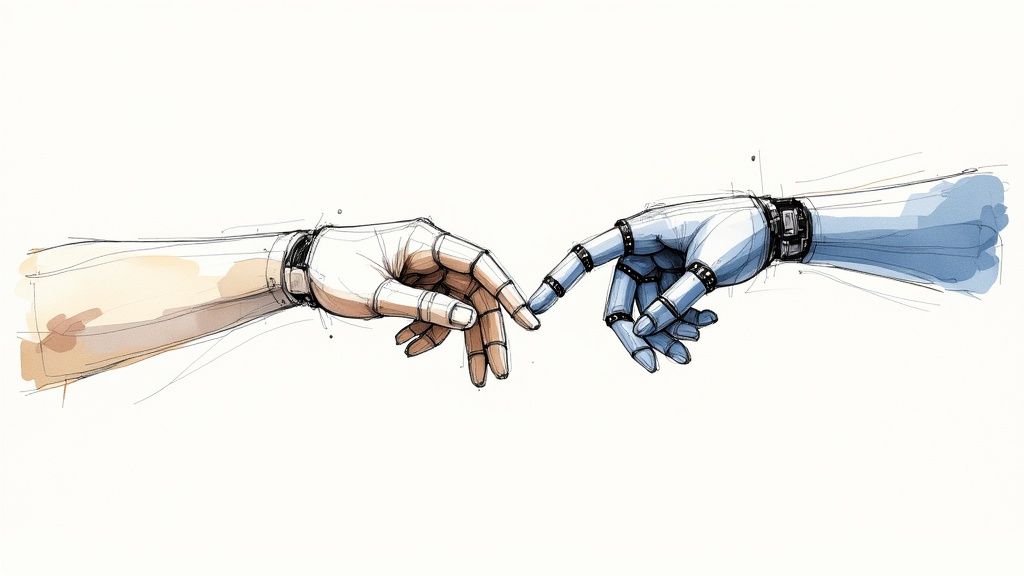 Across Germany, this collaborative model is quickly shifting from a buzzword into a business reality. The idea is to weave together the unique strengths of people and machines to create something far greater than the sum of its parts.
Across Germany, this collaborative model is quickly shifting from a buzzword into a business reality. The idea is to weave together the unique strengths of people and machines to create something far greater than the sum of its parts.
What AI brings to the table: It can process enormous datasets in seconds, spot subtle patterns, automate mind-numbing repetitive tasks, and execute commands with speed and accuracy.
What humans bring to the table: We provide the creativity, strategic foresight, emotional intelligence, and ethical reasoning needed to navigate complex, nuanced situations.
When you blend these strengths, organisations can innovate faster and make much smarter, more informed decisions. The first step is often developing a clear roadmap, which is where specialised AI strategy consulting comes in.
To make this partnership work, a few key elements must be in place. These can be thought of as the four pillars that support a strong, functional relationship between human teams and their AI counterparts.
The Four Pillars of Effective Human-AI Collaboration
Pillar | Description | Example in Practice |
|---|---|---|
Clear Roles & Responsibilities | Defining who does what. Humans and AI should have distinct, complementary roles based on their strengths. | A marketing team uses an AI to analyse customer data and suggest campaign segments, but the human marketer makes the final decision on messaging and creative direction. |
Trust & Transparency | Humans must be able to trust the AI's output. This requires transparency into how the AI works and its limitations. | A financial analyst's AI tool provides a confidence score with its predictions and flags when data quality is low, allowing the analyst to weigh its input appropriately. |
Seamless Integration | The AI system must fit naturally into existing human workflows, rather than creating friction or extra work. | An AI-powered assistant is integrated directly into a doctor's electronic health record system, summarising patient notes in real-time during a consultation. |
Continuous Feedback & Learning | The system needs to improve over time. This happens when humans provide feedback, correct errors, and guide the AI's learning process. | Customer service agents correct an AI chatbot's incorrect answers, which directly trains the model to be more accurate for the next user. |
Nailing these four pillars is what separates a frustrating, clunky AI tool from a truly collaborative partner that drives real value.
The Trust Gap in German AI Adoption
There's a significant hurdle, however. While AI use is on the rise in Germany, trust in the technology is lagging far behind. A recent KPMG study revealed that while 66% of Germans use AI in some form, only 32% actually trust the information it generates. This highlights a major gap between adoption and genuine confidence. You can dig into the specifics by reading the full KPMG report on German AI sentiment.
Building this trust is fundamental. An effective human-AI collaboration isn’t just built on powerful algorithms; it rests on a foundation of human confidence, clear governance, and a shared understanding of roles.
For any business serious about integrating AI, closing this trust gap is non-negotiable. It means taking a human-centric approach that puts clarity, control, and proven value first. This ensures that as AI’s role grows, so does our confidence in working alongside it.
Exploring the Core Models of Human-AI Interaction
When we talk about human-AI collaboration, it’s not a one-size-fits-all concept. Think of it less as a single relationship and more like a spectrum of teamwork. Just as you wouldn’t use a sledgehammer to hang a picture frame, the way you integrate AI depends entirely on what you’re trying to accomplish. Choosing the right model is fundamental to building an effective AI strategy framework that actually works in the real world.
The diagram below breaks down the main advantages that spring from a strong human-AI team-up.
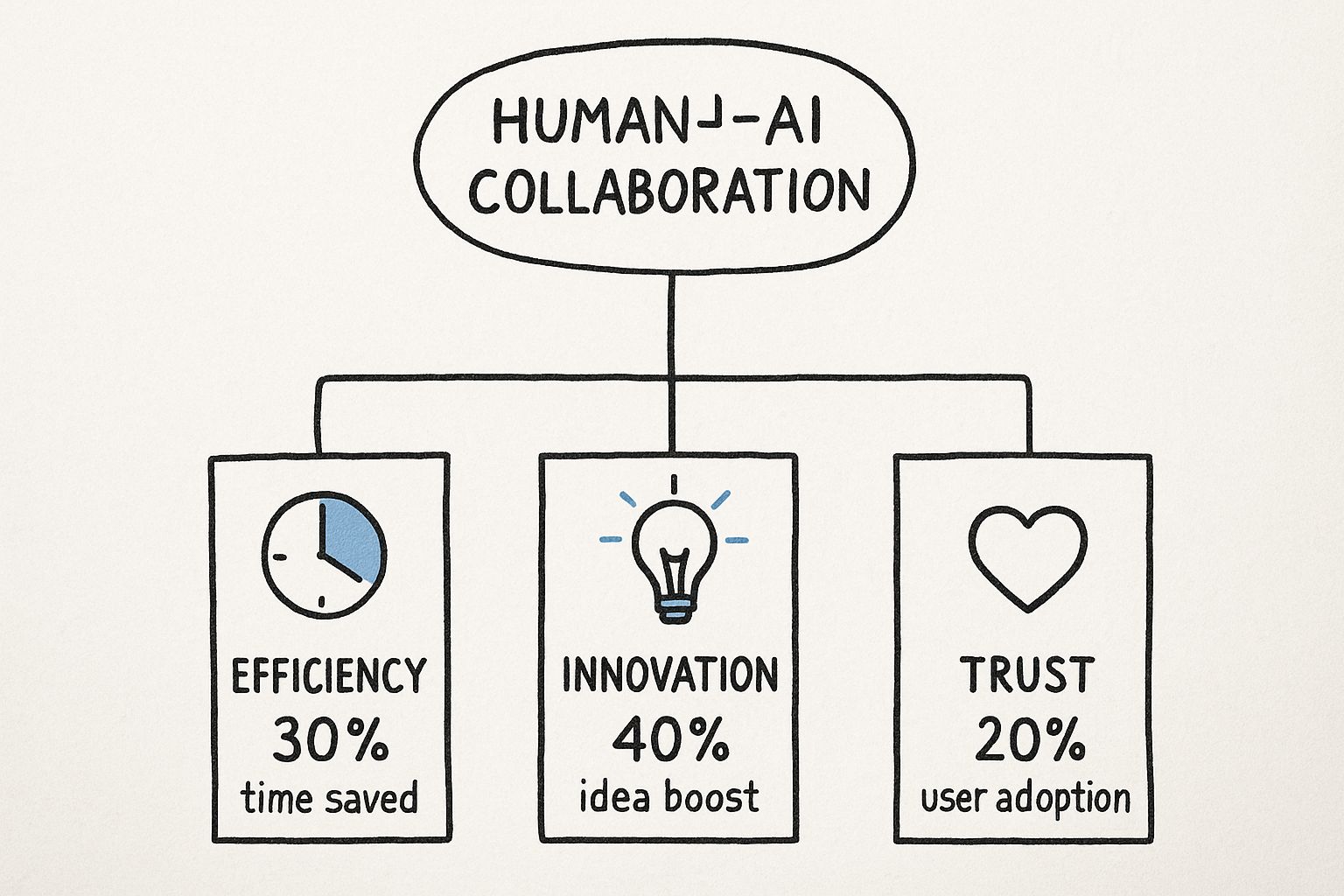
As you can see, innovation gets the biggest boost, with efficiency gains right behind it. This shows how these partnerships fuel both creativity and smoother operations. So, let’s dig into the four main ways this interaction happens to see how these benefits come to life.
Model 1: AI as a Tool
This is the most straightforward model. Here, the human is firmly in the driver's seat, and the AI is simply a powerful tool used to get a specific job done. The user gives the commands, and the AI executes them with a speed and precision we humans just can't match. The AI isn't making its own calls; it's just amplifying the user's abilities.
A great analogy is a graphic designer using an AI-powered image editor. The designer brings the creative vision and makes every artistic decision. The AI tool handles the grunt work instantly—like cutting out a background or generating pattern ideas—but it never dictates the creative direction. It’s a very smart paintbrush, but the human is always the artist.
Model 2: AI as an Assistant
In this model, the AI steps up to a more proactive, yet still secondary, role. It acts like a dependable personal assistant, taking care of routine, administrative, or data-gathering work. This frees up the human team member to focus on bigger, more strategic challenges. The AI works on its own within set boundaries, anticipating needs and managing simple workflows.
For example: An AI assistant can schedule meetings by scanning everyone's calendars, pinpointing a free slot, and sending out the invitations automatically.
Another example: A system that sorts through your inbox, filters emails by category, and flags the truly urgent messages for your attention.
Here, the human delegates tasks to the AI. This is often where organisations start their journey, as it offers clear wins in efficiency without needing to completely rip up and replace existing processes.
Model 3: AI as a Partner
This is where things get really interesting and true AI co-creation begins. In a partnership, humans and AI work side-by-side as peers. Each brings their unique strengths to the table to tackle a shared goal. The AI might analyse massive, complex datasets to spot patterns and suggest solutions a human would never find. The human then applies their own critical thinking, real-world context, and ethical judgement to those suggestions.
Think of a doctor working with an AI diagnostic system. The AI can sift through thousands of medical scans and patient histories to identify potential diseases with incredible accuracy. The doctor then takes that analysis and combines it with their own deep expertise and knowledge of the patient to make the final diagnosis and create a treatment plan.
This back-and-forth is key to solving complex problems and is a major focus for advanced AI strategy consulting. Of course, it demands a high level of trust and needs to be woven seamlessly into professional workflows.
Model 4: AI as a Coach
In the most advanced model, the AI takes on the role of a coach or mentor. Its main purpose isn't just to do a task, but to help the human do it better. It observes what the person is doing, analyses their performance data, and offers personalised feedback and guidance to help them improve.
This model is starting to show up in fields that demand incredible skill and precision. A surgeon, for instance, might use an AI coach that analyses their hand movements during an operation and gives feedback later to help refine their technique. Likewise, a sales professional could use a specialised tool to analyse call recordings and get tips on how to sharpen their pitch. It’s a shift from just completing work to actively building skills, using AI to make us better at what we already do.
What Are the Real-World Benefits of Working With AI?

It’s one thing to understand the theory behind how humans and AI can interact, but let's get to the real question: why should you care? The answer isn’t just about working faster. It's about working smarter, deeper, and with more creative freedom than ever before.
When human–AI collaboration moves from a buzzword to a core part of your daily operations, you see real, measurable advantages. We're talking about tangible impacts on your ability to innovate and make sharp, data-backed decisions. This is where a clear AI strategy framework can really make a difference, helping you identify which benefits will bring the most value to your business.
Make Sharper, More Confident Decisions
One of the biggest wins from this partnership is how it enhances human judgement. We humans are great at seeing the big picture and understanding nuanced context, but we’re easily overwhelmed by massive amounts of data. AI, on the other hand, is built for that very task.
When you pair a human expert with an AI analysis engine, you truly get the best of both worlds. The AI can sift through millions of data points, spotting hidden patterns and correlations that would be completely invisible to a person. The human expert then takes these machine-generated insights, applies their real-world experience, and makes the final, strategic call.
- Here’s a practical example: Imagine a supply chain manager using an AI to monitor global shipping routes, weather forecasts, and port traffic in real-time. The AI flags a potential delay and suggests three alternative routes, complete with cost and time estimates for each. The manager then uses their knowledge of supplier relationships and contractual terms to choose the absolute best option.
Spark Genuine Innovation and Creativity
True innovation isn’t a single 'eureka' moment. It’s a messy process of research, trial and error, and constant refinement. A lot of that process involves repetitive, time-sapping tasks that can drain the energy of even the most creative teams. This is where AI steps in as a powerful catalyst.
By automating the grunt work—like data gathering, sifting through market research, or producing a rough first draft—AI gives your team their time and mental energy back. Suddenly, they're free to do what people do best: think creatively, ask "what if?", and connect seemingly unrelated ideas in brilliant new ways. It's a shift from manual labour to truly imaginative and strategic thinking.
A pre-study of German media workers in 2025 revealed that while over 70% describe their work as creative, 32.5% see a high potential for AI to replace the more structured parts of their jobs. This reinforces the idea that AI’s biggest contribution is often in handling routine tasks, allowing professionals to focus on high-value creative and strategic work.
Drive Real, Measurable Business Value
At the end of the day, any business change has to deliver a return on investment. Human–AI collaboration really shines here, not just by creating efficiencies that boost your bottom line, but by opening doors to entirely new sources of revenue.
When you improve decision accuracy and speed up your innovation cycles, you naturally reduce costly mistakes and get new products or services to market much faster. This isn’t something you can leave to chance; it requires a deliberate, well-defined plan to make sure you capture that value.
This is why a robust AI strategy framework is so important. It gives you a clear roadmap that links your business goals directly to your AI implementation plan, ensuring every action is purposeful and turns the potential of human–AI collaboration into concrete business results.
How to Build Your Human-AI Collaboration Framework
So, you see the potential of human-AI collaboration. But moving from theory to practice? That requires a solid plan. Building an effective framework isn't about snapping up the latest shiny software; it’s about carefully weaving technology into the very fabric of your organisation.
Think of it as a practical, step-by-step process. The goal is to make sure the AI genuinely serves your people and your business objectives, creating a partnership that actually lasts and delivers results. A successful rollout starts not with the tech, but with your core business strategy.
Step 1: Define Clear and Specific Objectives
Before you even think about a tool or write a line of code, you have to answer the most important question: What problem are we actually trying to solve?
Vague ambitions like “improving efficiency” just won’t cut it. You need concrete, measurable goals that will act as your guide. For instance, are you trying to reduce customer service response times by 40%? Or maybe you want to boost the accuracy of your sales forecasts by 25%? Perhaps the aim is to free up your marketing team from manual data analysis by 10 hours a week.
Concrete goals act as your North Star. They keep the project focused, provide clear criteria for success, and help you communicate the value of the initiative to your entire team. Without this clarity, AI projects often drift and fail to deliver anything meaningful.
Step 2: Conduct a Thorough Requirements Analysis
Once you know what you want to do, the next step is figuring out how. This means taking a deep, honest look at your current processes, your data infrastructure, and your team's skills. A detailed AI requirements analysis is essential for understanding exactly what you’ll need from an AI solution.
This analysis should get to the bottom of a few key questions:
Data Readiness: What data do you have? Is it clean, accessible, and actually useful for training an AI model?
Process Mapping: Which specific workflows will this touch? Pinpoint the current bottlenecks and friction points where AI could make a real difference.
Technical Needs: What specific functions must the AI perform? Does it need to plug into your existing CRM, ERP, or other critical software?
User Skills: How tech-savvy is the team that will be using this tool every day? This will tell you how much training and support they’re going to need.
Getting this groundwork right prevents you from sinking money into a solution that simply doesn't fit.
Step 3: Select the Right Tools for the Job
Now that you have clear objectives and a detailed list of requirements, you can start looking at the technology. The market is flooded with options, from off-the-shelf software to fully custom-built models. The trick is to find the tool that aligns perfectly with the needs you've already identified.
For example, a tool like our AI Strategy consulting tool is built for leaders who need to quickly vet strategic AI opportunities without getting bogged down in technical jargon. It walks you through the process of matching AI capabilities with business goals, making it a great starting point for many organisations.
As you evaluate different tools, look at how easy they are to use, whether they can grow with you, their integration capabilities, and the quality of their customer support. The right tool should feel like a natural extension of your team, not another complex system to manage.
Comparing AI Integration Approaches
Choosing the right AI tool often means deciding on the right integration method. Not every company needs a bespoke, ground-up solution. The table below breaks down the common approaches to help you decide which path makes the most sense for your resources, goals, and technical maturity.
Approach | Best For | Pros | Cons |
|---|---|---|---|
Off-the-Shelf SaaS | Teams needing fast, proven solutions for common tasks (e.g., CRM, marketing). | Quick to deploy, low upfront cost, no in-house AI expertise needed. | Limited customisation, data might be handled by a third party, recurring fees. |
Platform-based (PaaS) | Organisations with some technical skill wanting to build on existing AI services. | More customisable than SaaS, access to powerful models (e.g., GPT, Claude). | Can be complex, requires development resources, potential for vendor lock-in. |
Custom In-House Build | Large enterprises with unique problems and significant technical resources. | Complete control, fully tailored to specific needs, IP ownership. | Very expensive, slow to develop, requires highly specialised talent to build and maintain. |
Ultimately, your choice depends on balancing speed, cost, and control. Start with what's most practical for your situation now, while keeping future needs in mind.
Step 4: Foster an AI-Ready Organisational Culture
Technology is only half the battle. Honestly, the biggest hurdle to successful human-AI collaboration is often cultural resistance. Your team needs to trust the tech, understand why it's being introduced, and feel confident using it. This doesn’t happen by accident; you have to intentionally build an AI-ready culture.
This involves a few key actions:
Transparent Communication: Be upfront about the 'why' behind the AI integration. Address fears about job replacement head-on by focusing on how AI will augment their roles and help them develop new skills.
Comprehensive Training: Provide hands-on training that goes beyond just clicking buttons. As we explored in our AI adoption guide, people need to understand the basics of how the AI works and how to critically interpret its suggestions.
Creating Champions: Find those enthusiastic early adopters in your teams. Empower them to become go-to guides for their peers and help smooth over the learning curve.
Step 5: Establish Strong Ethical Governance
Finally, a truly solid framework must include clear ethical guidelines and a governance plan. This is absolutely crucial for building trust, managing risk, and using AI responsibly.
This means setting clear policies on data privacy, algorithmic bias, and accountability. You need to answer tough questions proactively: Who is responsible if an AI makes a critical error? How will you audit your models to ensure they are fair and unbiased?
Thinking through these issues from the start is what separates a successful, long-term AI initiative from a risky gamble. By following these steps and guided by a clear AI strategy framework, you can move from simple ambition to real-world action, building a powerful and responsible synergy between your people and intelligent technology.
Human AI Collaboration in Action Across Germany

All the frameworks and models in the world only mean so much until you see them working in the flesh. Germany, with its formidable industrial base and drive for technological progress, provides some brilliant, real-world use cases of human-AI collaboration. These aren’t just futuristic ideas; they're practical applications delivering clear results right now.
Looking at how companies are actually putting these ideas to work helps turn theory into a successful, repeatable process. Germany is really leading the pack here, showing how to move from a strategic plan to a genuine operational advantage.
A big part of this success comes from strong government backing. The national AI strategy, supported by initiatives like the Civic Coding network, is creating an environment where everyone from start-ups to scientists can work together. This top-down support is speeding up the process of turning AI research into large-scale human-AI collaboration that touches multiple industries.
Industrie 4.0 Predictive Maintenance
In Germany’s world-renowned manufacturing sector—often called Industrie 4.0—human-AI teams are working together to prevent expensive shutdowns before they even start.
The Challenge: An unexpected equipment failure on a production line is a nightmare. It can stop everything for hours, sometimes days, costing millions in lost revenue. Sticking to a fixed maintenance schedule isn't always efficient; you're either servicing machines too early or, worse, too late.
The Collaborative Solution: Imagine an AI system constantly watching over thousands of sensors on factory equipment, analysing everything from vibration patterns to temperature fluctuations. It’s trained to spot tiny, almost invisible anomalies that often signal a future breakdown. When it finds something, it doesn't just sound a generic alarm. It alerts a human technician with a specific diagnosis and points out which parts likely need attention.
The technician then steps in, using their hands-on experience to check the AI's findings, schedule the repair during a planned quiet period, and carry out the work.
This partnership shifts maintenance from a reactive firefight to a proactive, intelligent strategy. The AI does the heavy lifting with the data, while the human brings the critical skills and final judgment call.
Healthcare Diagnostics in Radiology
German healthcare is another area where this partnership is having a life-changing impact, especially when it comes to reading medical scans.
The Challenge: Radiologists have an immense responsibility. They must analyse hundreds of complex scans like MRIs and CTs every day, and accuracy is non-negotiable. The sheer volume can be draining, which naturally increases the risk of missing a tiny, early-stage sign of disease.
The Collaborative Solution: An AI model, which has learned from millions of anonymised medical images, serves as a highly effective screening partner. It meticulously goes through every scan, highlighting suspicious areas that might point to tumours or other problems.
The human radiologist then reviews the scans that the AI has flagged. This is where their deep medical knowledge is irreplaceable. They interpret the AI's suggestions in the context of the patient's full history, confirming a diagnosis or ruling out a false positive. It’s a powerful safety net, blending the AI's tireless precision with the radiologist's essential expertise.
Financial Services and Fraud Detection
In Germany's financial sector, the name of the game is protecting customers from ever-more-cunning fraud schemes. This requires a smart blend of human insight and machine speed.
The AI's Role: An AI system monitors millions of transactions as they happen. It's looking for unusual spending patterns that don't fit a customer's typical behaviour—a strange location, an odd amount, or unusual timing. It can instantly flag a transaction as potentially fraudulent.
The Human's Role: The system immediately alerts a human fraud analyst. This is where judgment comes in. The analyst investigates further, perhaps calling the customer to check if the purchase was real or looking at other recent account activity. This human touch is vital for preventing legitimate transactions from being blocked and for handling the tricky, nuanced cases where context is everything.
These examples make one thing crystal clear: the most effective use of AI isn't about replacing people, but about augmenting their abilities. For any business thinking about implementing similar solutions, a structured plan is vital. Exploring something like a dedicated https://www.ekipa.ai/workshop can help your team pinpoint where this collaboration will have the biggest impact, turning that potential into real-world results.
Right, so where do you actually begin?
Embarking on human-AI collaboration isn't about flipping a switch and watching everything change overnight. Think of it less as a giant technological leap and more as a careful, people-first evolution. As we've seen, success comes down to having a clear vision, a supportive culture, and a genuine commitment to amplifying your team's talents, not just replacing them. It's about forging a real partnership between human intuition and machine efficiency.
For any business that wants to stay relevant and grow in a meaningful way, this isn't just a "nice-to-have"—it's a necessity. The trick is not to get bogged down by the sheer scale of it all. The key is to think small, at least at first.
Charting Your Path Forward
The best way forward is to start with a single project and build from there. Forget trying to reinvent your entire organisation in one go. Instead, pinpoint one specific, nagging problem where AI could make a real difference. A successful pilot project does more than just solve a problem; it builds the confidence and organisational buy-in you'll need to expand later.
Successful integration is ultimately about strategy, culture, and people—not just technology. The best AI tools will fail if they aren’t embraced by the teams meant to use them, or if they aren't aligned with clear business goals.
Think of this first project as your training ground. It’s where you'll get to grips with the practical challenges, fine-tune your approach, and show a tangible return on investment. From that solid foundation, you can start expanding your efforts, guided by a robust AI strategy framework that can grow with you. As we touched on in our AI adoption guide, a well-defined proof-of-concept is the bedrock of long-term success, helping you map out everything from data needs to team training.
From Knowledge to Action
Turning all this understanding into concrete action requires a clear game plan. It means setting achievable objectives, carrying out a thorough AI requirements analysis to understand what you truly need, and picking the right tools for the job. Creating a truly symbiotic human-AI workplace is a marathon, not a sprint—it involves constant learning and adapting as you go.
To make that leap from theory to practice, it often helps to have the right partner. The road to effective AI integration has its complexities, but you don't have to walk it alone. For the strategic guidance and practical support needed to navigate this shift successfully, feel free to connect with our expert team.
Frequently Asked Questions About Human-AI Collaboration
Diving into human-AI collaboration naturally brings up a lot of questions. We find that getting clear, straightforward answers is what gives leaders the confidence to build a solid strategy. Let’s tackle some of the most common queries we hear from businesses across Germany.
Will AI Replace Human Jobs in Germany?
This is probably the number one question on everyone's mind. The honest answer is that the goal isn't replacement; it's augmentation. Think of it this way: AI is best suited to handle the repetitive, structured tasks that often bog down our days.
This frees up your team to focus on the things humans excel at—strategic thinking, creative problem-solving, and navigating complex situations that require real nuance. Instead of eliminating jobs, human-AI collaboration evolves them, creating new roles focused on guiding and working alongside these intelligent systems.
What Is the Biggest Challenge to Successful AI Integration?
You might think the biggest hurdle would be the technology itself, but it's almost always cultural. You can have the most sophisticated AI on the planet, but if your team doesn't trust it or understand its purpose, the initiative is likely to fall flat.
The real work lies in building an AI-ready culture. This means being transparent, establishing clear ethical guidelines, and providing training that turns apprehension into genuine engagement. When people feel confident in the technology and its role, resistance melts away.
How Can a Small or Medium-Sized German Business (SME) Get Started?
You don't need to launch a massive, company-wide programme right out of the gate. For most SMEs, the smartest move is to start small. Pinpoint a single, specific problem where AI could make a noticeable, measurable difference.
Maybe it's automating customer data analysis to uncover new sales leads or using AI to streamline your inventory management and cut down on waste. A focused project like this lets you learn the ropes, demonstrate a clear return on investment, and build the momentum needed for wider adoption.
For more in-depth answers, feel free to explore our full FAQ page.

